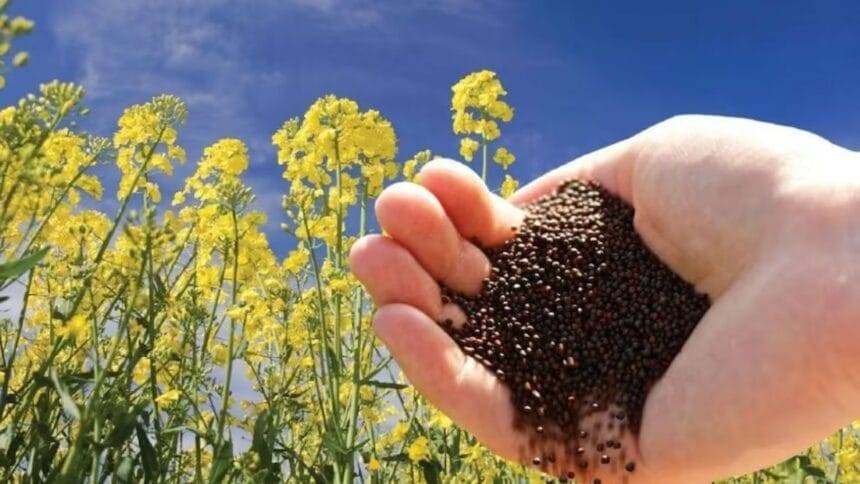Main Points In Hindi (मुख्य बातें – हिंदी में)
यहाँ कुछ मुख्य बिंदु दिए गए हैं जो आपके पाठ का सारांश प्रस्तुत करते हैं:
-
तेल की फसलों की बढ़ती कीमतें: किसानों को खाद्य तेलों की कीमतों में वृद्धि को देखते हुए, अधिक तेल बीज फसलों की बुवाई करने का सुझाव दिया गया है।
-
सरसों की खेती का लाभ: सरसों, जो रबी मौसम की मुख्य तेल बीज फसल है, कम जल, उर्वरक और सिंचाई की आवश्यकता के साथ अच्छे लाभ के लिए एक बेहतर विकल्प है। छोटे अवधि की सरसों की किस्में भी अभी भी उगाई जा सकती हैं।
-
छोटी अवधि की सरसों की किस्में: किसान पेंट और अन्य रबी फसलों के साथ इंट्रक्रॉपिंग करने के लिए जल्दी परिपक्व छोटी अवधि की सरसों की किस्में (जैसे Pusa Tarak और Pusa Mustard 28) उगा सकते हैं, जो अधिक उत्पादन और लाभ लाएगी।
-
बुवाई का समय और तकनीक: छोटी अवधि की सरसों की बुवाई सितंबर से दिसंबर के बीच की जा सकती है। सही दूरी और बुवाई का ध्यान रखते हुए, इसका उत्पादन बढ़ाया जा सकता है।
- सिंचाई और उपज बढ़ाने के तरीके: सरसों की पहली सिंचाई पहले फूल आने पर और दूसरी सिंचाई फली के बनने के दौरान की जानी चाहिए। यह फसल अन्य फसलों के साथ मिलाकर बेहतर लाभ दे सकती है।
ये बिंदु किसानों को वर्तमान स्थिति में सरसों की खेती के लाभ और सीमित संसाधनों के साथ अधिक लाभ कमाने के उपायों को दर्शाते हैं।


Main Points In English(मुख्य बातें – अंग्रेज़ी में)
Here are the main points from the provided text regarding the cultivation of short-duration mustard varieties:
-
Increased Cultivation Potential: Due to the rising prices of edible oils, farmers can increase sowing of oilseed crops, particularly mustard, which is a profitable option requiring less irrigation and fertilizer.
-
Short-Duration Mustard Varieties: Farmers can still plant short-duration mustard varieties in November-December, allowing them to harvest sooner and potentially sow Zaid crops on time. These varieties mature in 100 to 125 days.
-
Intercropping Opportunities: Short-duration mustard can be cultivated alongside other Rabi crops like wheat, rice, and peas, maximizing space and increasing overall crop yield and profits.
-
Specific Varieties and Yields: Highlighted mustard varieties, such as Pusa Tarak and Pusa Mustard 28, offer high yields and oil content, making them suitable for different regions in India. For example, Pusa Mustard 28 yields an average of 19.93 quintals per hectare and is ready for harvest in 107 days.
- Irrigation and Seed Sowing Guidelines: Proper irrigation should be employed, particularly at critical growth stages. Farmers require about 6 kg of seeds per hectare and should maintain specified distances between plants and rows for optimal growth.
Complete News In Hindi(पूरी खबर – हिंदी में)
खाद्य तेलों की कीमतों में निरंतर वृद्धि को देखते हुए, किसान तेल बीज फसलों की बुवाई बढ़ा सकते हैं। सरसों, जो कि रबी मौसम की मुख्य तेल बीज फसल है, कम सिंचाई और कम खाद-पानी के साथ अच्छी आमदनी का बेहतर विकल्प है। यदि आपने अभी तक सरसों की फसल नहीं बोई है, तो चिंता करने की कोई जरूरत नहीं है। छोटी अवधि वाली सरसों की किस्में आपकी मदद कर सकती हैं। आप इन किस्मों को रबी फसलों के साथ अंतर फसल या मिश्रित खेती के रूप में उगा सकते हैं, इससे आपको अधिक लाभ होगा और फसल भी जल्दी पक जाएगी। इससे आप ज़ायद फसलों की बुवाई समय पर कर सकेंगे।
लंबी अवधि की किस्मों की बुवाई अक्टूबर तक की जाती है। यदि इसकी बुवाई देरी से की जाती है, तो उत्पादन कम होता है। इसलिए, अब किसान नवंबर-दिसंबर में छोटी अवधि वाली सरसों की खेती कर सकते हैं। आईएआरआई पुसा की कुछ छोटी अवधि की सरसों की किस्में हैं, जो जल्दी पकती हैं और सामान्यत: 100 से 125 दिनों में तैयार हो जाती हैं। इसका मतलब है कि यदि लंबी अवधि की किस्में अभी तक नहीं बोई गई हैं, तो किसान छोटी अवधि की किस्मों की बुवाई करके अपनी आय बढ़ा सकते हैं। किसान इसे गेहूं, चावल, मटर और अन्य रबी फसलों के साथ अंतर फसल के रूप में उगा सकते हैं। इस तरह, किसान कम जगह में अधिक फसलें उगा सकते हैं, जिससे लाभ बढ़ता है।
यह भी पढ़ें: डीएपी संकट: डीएपी संकट क्यों उत्पन्न हुआ, मांग और आपूर्ति में क्या अंतर है?
छोटी अवधि वाली सरसों की किस्में
- पुसा यहारक: यह किस्म पंजाब, हरियाणा, दिल्ली, राजस्थान, और पश्चिमी उत्तर प्रदेश में उगाने के लिए बेहतर है। इसका तेल मानव उपयोग के लिए अंतरराष्ट्रीय मानकों के अनुसार बेहतर है। इसका औसत उत्पादन 19.24 क्विंटल प्रति हेक्टेयर है और इसे 121 दिनों में तैयार किया जा सकता है।
- पुसा सरसों 28 (NPJ-124): यह मैदानों में उगाने के लिए एक बेहतर किस्म है। यह समय पर सिंचाई वाले क्षेत्रों के लिए उपयुक्त है, औसत उपज 19.93 क्विंटल प्रति हेक्टेयर है और इसमें 41.5% तेल होता है। यह 107 दिनों में पक जाती है और इसकी उच्च तेल सामग्री के कारण किसानों के लिए लाभदायक है।
- पुसा सरसों 25: यह पुसा संस्थान द्वारा विकसित एक लोकप्रिय छोटी अवधि कीसरसों की किस्म है। इसका उत्पादन अधिक होता है और इसमें 39.6% तेल होता है। यह किस्म राजस्थान, हरियाणा, पंजाब, दिल्ली, जम्मू और कश्मीर, पश्चिमी उत्तर प्रदेश और हिमाचल प्रदेश के क्षेत्रों में उगाने के लिए अत्यंत उपयुक्त है।
- पुसा लीडिंग सरसों: यह किस्म उच्च उत्पादन के लिए जानी जाती है और यह रोगों के प्रति प्रतिरोधी है। इसका औसत उत्पादन 17.5 क्विंटल प्रति हेक्टेयर है और इसमें उच्च तेल सामग्री है। यह 110 दिनों में पक जाती है, जिससे इसे धान की कटाई के बाद भी बोया जा सकता है। यह उत्तरी भारत, पंजाब, हरियाणा और राजस्थान में उगाने के लिए बेहतर मानी जाती है।
बुवाई का समय और बीज की मात्रा
सरसों की बुवाई का समय किस्मों के हिसाब से भिन्न होता है। लंबे समय की किस्मों की बुवाई अक्टूबर के दूसरे या तीसरे सप्ताह में की जाती है, जबकि छोटी अवधि की किस्मों की बुवाई सितंबर से दिसंबर के बीच की जाती है। बुवाई के लिए प्रति हेक्टेयर 6 किलोग्राम बीज की जरूरत होती है। बुवाई के दौरान पौधों के बीच 15 सेमी और पंक्तियों के बीच 40 सेमी की दूरी रखनी चाहिए।
सिंचाई की विधि
सरसों की फसल में पहली सिंचाई पहले फूल आने पर की जानी चाहिए, दूसरी सिंचाई फलों के बनने के दौरान की जाती है। किसान इसे गेहूं या अन्य फसलों के साथ उगाकर अच्छा लाभ कमा सकते हैं। किसान जो फरवरी में गन्ना या जल्दी सब्जियां, या जनवरी में प्याज और लहसुन लगाना चाहते हैं, वे भी छोटी अवधि वाली सरसों की फसल की खेती से लाभ उठा सकते हैं। इस प्रकार, छोटी अवधि वाली सरसों की खेती लाभप्रद साबित हो सकती है।
यह भी पढ़ें: भारत ने डोनाल्ड ट्रंप के शासन के दौरान अमेरिका के खिलाफ बड़ा कदम उठाया, जानें क्यों ‘प्रतिवाद शुल्क’ लगाया गया
Complete News In English(पूरी खबर – अंग्रेज़ी में)


In view of the continuous increase in the prices of edible oils, farmers can increase the sowing of oilseed crops. Cultivation of mustard, the main oilseed crop of Rabi season, is a better option for good earning with less irrigation and less fertilizer and water. If you have not planted mustard crop yet, there is no need to worry. Mustard varieties with short duration can help you. You can grow these varieties as intercropping or mixed farming with Rabi crops, so that you can get more profit along with early ripening of the crop. With this you will be able to sow Zaid crops on time.
Sowing of long duration varieties of mustard is done till October. If its sowing is done late, the yield is less. Therefore, now farmers can cultivate short duration mustard in November-December. IARI Pusa has short duration mustard varieties, which are early maturing and generally ready in 100 to 125 days. This means that if long duration varieties have not been sown yet, farmers can increase their income by sowing short duration varieties. Farmers can grow it with wheat, rice, peas and other Rabi crops as intercropping. Thus, farmers can grow more crops in less space, thereby increasing profits.
Read this also: DAP Crisis: Why did DAP crisis arise, what is the difference between demand and supply?
Short duration mustard varieties
- Pusa Tarak: This variety is better to grow in Punjab, Haryana, Delhi, Rajasthan, and Western Uttar Pradesh. This makes the oil better for human use as per international standards. Its average yield is 19.24 quintals per hectare and it is ready in 121 days.
- Pusa Mustard 28 (NPJ-124): This is a better variety for growing in plain areas. It is suitable for timely irrigated areas, with an average yield of 19.93 quintals per hectare and oil content of 41.5%. It becomes ripe in 107 days and is beneficial for farmers due to its high oil content.
- Pusa Mustard 25: It is a popular short duration variety of mustard, developed by Pusa Institute. It gives more yield. The oil content in it is 39.6%. This variety is highly suitable for cultivation in Rajasthan, Haryana, Punjab, Delhi, Jammu and Kashmir, Western Uttar Pradesh and Himachal Pradesh regions.
- Pusa Leading Mustard: This variety is known for high yield and is resistant to diseases. Its average yield is 17.5 quintals per hectare and it has high oil content. It becomes ripe in 110 days, due to which it can be sown even after harvesting of paddy. This variety is considered better for growing in North India, Punjab, Haryana and Rajasthan.
Sowing time and quantity of seeds
The time of sowing of mustard varies depending on the species. Sowing of long duration varieties is done in the second or third week of October, while sowing of short duration varieties can be done from September to December. For sowing, 6 kg seeds are required per hectare. During sowing, a distance of 15 cm should be maintained between plants and 40 cm between rows.
irrigation method
In mustard crop, first irrigation should be done when the first flower appears, second irrigation should be done during the formation of pods. Farmers can earn better profits by growing it with wheat or other crops. Farmers who want to plant sugarcane or early vegetables in February, or cultivate onions and garlic in January, can also benefit from the cultivation of short duration mustard varieties. Thus, short duration mustard cultivation can prove to be quite profitable.
Read this also: India took major action against America during Donald Trump’s rule, know why ‘retaliation fee’ was imposed




